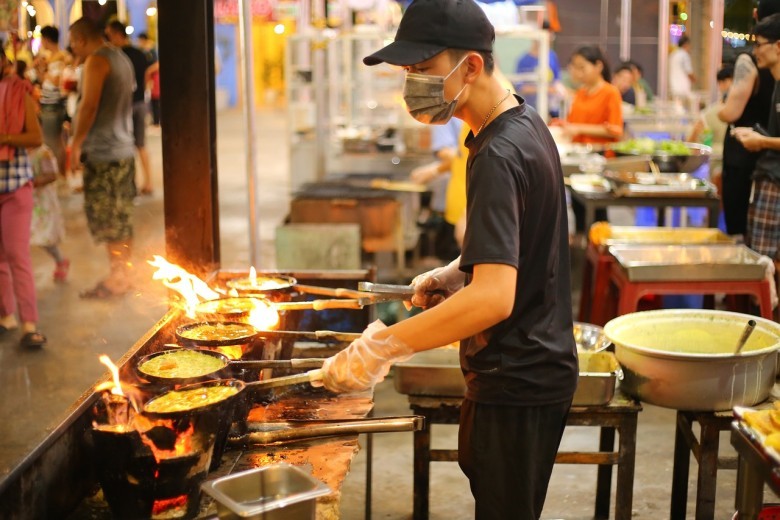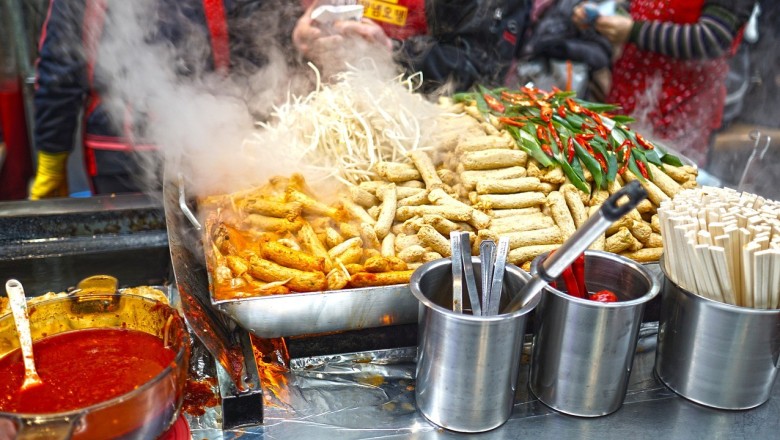
The Essence of Street Food Culture
Street food is an integral part of the culinary landscape in many countries around the world. It represents more than just a quick, convenient meal; it is a window into the culture, traditions, and everyday life of a place. From bustling markets in Asia to the vibrant food trucks of the Americas, each region offers a unique twist on what street food means to its people.
Historical Significance
The tradition of street food dates back centuries, with ancient civilizations such as the Romans and Chinese having their own versions of food vendors. These early examples of street food were a necessity for urban populations, providing sustenance for those who didn't have the means to prepare their own meals. Over time, street food has evolved, but its core purpose of feeding the masses affordably and efficiently remains unchanged.
Diversity of Flavors and Dishes
The variety of street food available across the globe is staggering. Each country, city, and even neighborhood can have its own specialty. From savory snacks like tacos and kebabs to sweet treats like churros and bubble waffles, the flavors are as diverse as the locations they come from. This diversity is a testament to the creativity and adaptability of street food vendors, who often infuse their offerings with local ingredients and culinary techniques.
Social and Economic Impact
Street food is not only about the food itself but also about the social interactions and economic opportunities it fosters. It is a communal experience, often enjoyed in public spaces where people from all walks of life can come together. Economically, it provides livelihoods for millions of people worldwide, acting as a stepping stone for entrepreneurs and small business owners to enter the food industry.
Health and Safety Considerations
While street food is celebrated for its flavor and accessibility, there are also important health and safety considerations. Many countries have regulations in place to ensure that street food is prepared and sold in a manner that is safe for consumption. Vendors who adhere to these standards help to maintain the reputation of street food as not only delicious but also reliable.
The Role of Street Food in Tourism
For travelers, street food offers an authentic taste of local cuisine without the formality of a sit-down restaurant. It's an attraction in its own right, drawing food enthusiasts who are eager to explore the culinary delights that can only be found on the streets. The rise of food tourism has further highlighted the importance of street food in the global gastronomic scene.
Sustainability and Innovation
In recent years, there has been a growing emphasis on sustainability within the street food industry. Vendors are increasingly using locally sourced and environmentally friendly materials, from biodegradable utensils to solar-powered food carts. Innovation is also key, with many street food entrepreneurs experimenting with new dishes and fusion cuisine, pushing the boundaries of traditional street food.
The Future of Street Food
As the world becomes more interconnected, the influence of street food continues to expand. With the advent of social media and food-sharing platforms, street food trends can quickly gain international attention, inspiring new culinary creations and exchanges. The future of street food looks bright, with its ability to adapt to changing tastes and global challenges, ensuring that it will remain a beloved part of our food culture for generations to come.
Asia's Street Food Scene: A Taste of Tradition and InnovationThe Rich Tapestry of Traditional Street Foods
Asia's street food scene is a vibrant and integral part of its culture, offering a window into the region's rich culinary heritage. Each country boasts its own array of traditional street foods, deeply rooted in history and tradition. In Thailand, for instance, the bustling streets are filled with the aroma of Pad Thai, a stir-fried noodle dish with a balance of sweet, sour, and savory flavors, often served with a squeeze of lime and crushed peanuts. Meanwhile, in Vietnam, the iconic Pho—a fragrant beef or chicken noodle soup—provides comfort at any time of the day.
Moving to East Asia, China's street food scene is as diverse as its provinces, with delicacies like Jianbing, a savory crepe typically filled with egg, green onions, and hoisin sauce, originating from the northern regions. Japan's Takoyaki, ball-shaped snacks filled with diced octopus, are a staple in Osaka's street food culture, showcasing the Japanese precision in creating bite-sized delights.
India's streets are a feast for the senses, with Chaat varieties offering a symphony of flavors, textures, and colors. From the tangy and spicy Pani Puri to the sweet and savory Bhel Puri, these snacks are an essential part of the Indian street food experience.
Innovation and Fusion: The New Wave of Street Eats
As the world becomes more interconnected, Asia's street food scene is not immune to the winds of change and innovation. Modern twists on classic dishes are emerging, with vendors and chefs experimenting with new ingredients and fusion flavors. In South Korea, traditional Tteokbokki, a dish of chewy rice cakes in a spicy sauce, is now found in variations that include cheese, seafood, and even carbonara-inspired sauces.
Singapore's hawker centers, a cornerstone of the local food scene, are seeing a new generation of chefs who are redefining traditional dishes. For example, the classic Hainanese Chicken Rice is being reinvented with sous-vide techniques to achieve the perfect texture and flavor.
The Role of Street Food in Asia's Culinary Identity
Street food is not just about sustenance; it plays a crucial role in shaping Asia's culinary identity. It reflects the everyday life of its people, the history of its nations, and the creativity of its cooks. In the Philippines, the humble Balut—a fertilized duck egg—tells a story of resourcefulness and tradition, while Japan's street-side Ramen stalls speak to the fast-paced lifestyle of its urban dwellers.
Sustainability and the Future of Street Food
With the rise of environmental awareness, sustainability has become a significant concern in Asia's street food culture. Efforts are being made to reduce waste and promote eco-friendly practices. Biodegradable utensils and packaging are becoming more common, and there is a growing trend towards locally sourced and organic ingredients.
The future of street food in Asia is a dynamic interplay between maintaining tradition and embracing innovation. As new trends emerge and tastes evolve, the street food scene continues to be a testament to Asia's adaptability and culinary diversity.
Latin America's Sizzling Street Eats: From Tacos to TamalesTacos: Mexico's Ultimate Street Food
Tacos are perhaps the most iconic street food in Latin America, particularly in Mexico. They consist of small, soft tortillas filled with a variety of ingredients such as grilled meats, fresh vegetables, and zesty salsas. The beauty of tacos lies in their diversity; from the classic al pastor, marinated pork carved from a spit and served with pineapple, to the simplicity of tacos de canasta, which are steamed and kept warm in cloth-covered baskets.
Tamales: A Wrapped Delight
Tamales are another staple of Latin American street cuisine, with each country offering its own twist on the dish. These parcels of masa (corn dough) are filled with meats, cheeses, fruits, or vegetables and then wrapped in corn husks or banana leaves before being steamed. In Mexico, you might find tamales filled with red or green salsa and chicken, while in Central America, the dough is often mixed with a savory or sweet filling.
Arepas: The South American Staple
Originating from the northern region of South America, arepas are thick, round corn cakes that are grilled, baked, or fried. They can be split open and stuffed with a variety of fillings such as cheese, ham, pulled pork, or black beans. In Venezuela and Colombia, arepas are a popular street food, enjoyed at any time of the day.
Empanadas: The Perfect Pocket
Empanadas are crescent-shaped pastries filled with a variety of savory ingredients, such as beef, chicken, cheese, or vegetables. They can be baked or fried, resulting in a crispy exterior with a hot, flavorful filling. Each Latin American country has its own version of the empanada, making them a versatile and widely enjoyed street food.
Churros: A Sweet Treat
While not a meal in themselves, churros are an essential part of the street food experience in Latin America. These long, fried dough pastries are often coated in sugar and served with a side of hot chocolate or dulce de leche for dipping. They provide a sweet end to any street food feast.
Pupusas: El Salvador's Stuffed Sensation
Pupusas are thick, handmade corn tortillas filled with a blend of cheese, beans, and often pork. They are cooked on a griddle until the exterior is lightly crispy while the inside remains soft and gooey. Served with a side of curtido, a spicy cabbage slaw, and tomato salsa, pupusas are a satisfying street food unique to El Salvador.
Ceviche: A Coastal Delicacy
Ceviche is a refreshing dish made from fresh raw fish cured in citrus juices, typically lime or lemon, and spiced with chili peppers. It's often garnished with onions, cilantro, and salt. While not a traditional "street food," it's commonly found in coastal regions of Latin America, particularly in Peru, where it's served in markets and from ceviche carts.
Anticuchos: Grilled Skewers with a Twist
Anticuchos are a type of street food found in various countries, but they are especially popular in Peru. These skewers of marinated meat, typically beef heart, are grilled over an open flame and served with boiled potatoes and corn. The marinade, a blend of vinegar, spices, and herbs, gives anticuchos their distinctive flavor.
Acarajé: A Brazilian Specialty
Acarajé is a street food from Brazil, particularly the state of Bahia. These deep-fried balls made from black-eyed peas are split open and filled with vatapá (a creamy paste made from shrimp, bread, ground peanuts, and palm oil) and caruru (a dish made from okra, onion, shrimp, and toasted nuts). Acarajé is a fusion of African and Brazilian flavors, reflecting the country's diverse cultural heritage.
European Street Delicacies: Beyond Pretzels and WafflesSpanish Churros
Originating from Spain, churros are a popular street food found across the country, especially at breakfast time. These long, fried dough pastries are traditionally dipped in hot chocolate or café con leche. They are often dusted with sugar and can sometimes be filled with chocolate or dulce de leche for an extra sweet treat.
Dutch Stroopwafels
While waffles are common in Europe, the Dutch stroopwafel is a unique take on the concept. Two thin waffle layers are filled with a sticky caramel-like syrup called 'stroop'. They are best enjoyed warm, often placed atop a steaming mug of coffee or tea to soften the syrup inside.
Italian Arancini
Arancini are crispy, fried balls of rice originating from Sicily. These savory snacks are filled with a variety of ingredients such as mozzarella, peas, mushrooms, or ragù (meat sauce). They are a staple of Sicilian cuisine and have become a beloved street food throughout Italy.
French Crêpes
Crêpes are thin pancakes that can be found in street-side stands all over France. They can be served with a variety of fillings, both sweet and savory. Sweet options include Nutella, sugar, and fruit, while savory versions might contain cheese, ham, and eggs.
Greek Souvlaki
Souvlaki consists of small pieces of meat and sometimes vegetables grilled on a skewer. It is often served wrapped in a pita with garnishes such as tomatoes, onions, and a sauce like tzatziki. This street food is a common sight in Greece and has a rich flavor profile thanks to the marinades and fresh ingredients.
Czech Trdelník
Trdelník, also known as chimney cake, is a sweet pastry that's common in Czech streets, particularly Prague. It's made from rolled dough that's wrapped around a stick, then grilled and topped with sugar and walnut mix. The inside is often coated with chocolate or filled with ice cream.
Turkish Simit
Simit is a circular bread, encrusted with sesame seeds, and is sometimes referred to as Turkish bagel. It's a common street food in Turkey, often eaten for breakfast or as a snack throughout the day. Simit can be enjoyed plain, with tea, or with various fillings like cheese or jam.
Portuguese Pastéis de Nata
These are egg tart pastries that originated in Portugal. Pastéis de Nata are characterized by their creamy custard center and flaky crust, often sprinkled with cinnamon and powdered sugar. They are a staple in Portuguese bakeries and a must-try for visitors.
Scandinavian Smørrebrød
Smørrebrød are open-faced sandwiches from Denmark and other Scandinavian countries. They consist of a slice of buttered rye bread topped with cold cuts, pieces of meat or fish, cheese or spreads, and garnishes. These are commonly found in street markets and are known for their high-quality ingredients and beautiful presentation.
Hungarian Lángos
Lángos is a Hungarian street food favorite, consisting of deep-fried dough topped with garlic butter, sour cream, and grated cheese. Other toppings can include mushrooms, sausages, or even sweet jams. It's a versatile dish that can be eaten as a snack or a full meal.
Polish Pierogi
Pierogi are filled dumplings of Central and Eastern European origin. These crescent-shaped pockets are stuffed with a variety of fillings, including potato, sauerkraut, ground meat, cheese, and fruits. They are boiled, baked or fried and often served with sour cream, onions, or bacon bits.
British Fish and Chips
A quintessential British street food, fish and chips consist of battered and fried fish served with a heap of hot chips. This dish is often accompanied by tartar sauce, mushy peas, or vinegar. It's a staple of British seaside towns and is enjoyed by locals and tourists alike.
Belgian Frites
Belgian frites are thick-cut fries, traditionally double-fried for a crispy exterior and fluffy interior. They are typically served in a paper cone with a variety of sauces to choose from, such as mayonnaise, ketchup, or curry. Frites stands can be found throughout Belgium and are a national favorite.
African Street Food: A Melting Pot of FlavorsThe Rich Tapestry of African Cuisine
African street food is as diverse as the continent itself, reflecting a rich tapestry of cultures, ethnic groups, and histories. Each region offers a unique blend of flavors, ingredients, and cooking techniques that have been influenced by indigenous traditions, colonial legacies, and modern innovations.
West African Street DelightsJollof Rice
Originating from the Senegambia region, Jollof rice is a beloved street food across West Africa. This one-pot dish features rice cooked in a flavorful tomato sauce with onions, spices, and often includes vegetables, fish, or meat.
Suya
Suya is a popular spicy skewered meat, found especially in Nigeria. It's made from thinly sliced beef, chicken, or ram meat, marinated in a mixture of ground peanuts and spices, then grilled over an open flame.
Puff-Puff
A common sight in West African markets, puff-puff is a deep-fried dough ball, similar to a doughnut. It's often enjoyed as a snack or dessert, sometimes with a sprinkle of sugar or a dip in a spicy sauce.
East African Street EatsNyama Choma
In East Africa, particularly Kenya and Tanzania, nyama choma, which means "grilled meat" in Swahili, is a staple. Goat, beef, or chicken is seasoned and slow-grilled to perfection, often served with ugali (a maize flour porridge) and kachumbari (a fresh tomato and onion salad).
Injera with Tibs
Ethiopia's injera, a sourdough-risen flatbread with a unique, spongy texture, is typically served with tibs – sautéed meat or vegetables. Street vendors often offer this combination, providing a quick, filling meal.
North African Street FareTagine
Morocco's streets are fragrant with the smell of tagine, a slow-cooked stew named after the conical clay pot it's cooked in. Ingredients vary, but common additions include lamb, chicken, vegetables, and a blend of aromatic spices.
Brik
Tunisia's brik is a thin pastry enveloping a filling of egg, tuna, harissa, and capers, then deep-fried until crispy. It's a popular fast food, especially during Ramadan.
Southern African Quick BitesBunny Chow
South Africa offers the unique bunny chow, a hollowed-out loaf of bread filled with curry. It originated in the Durban Indian community and has become a beloved street food across the country.
Sadza
In Zimbabwe, sadza is the street food of choice. This maize-based staple is similar to South Africa's pap and is often accompanied by grilled meat or vegetables.
Central African TreatsMoambe Chicken
The Democratic Republic of Congo is known for moambe chicken, a dish featuring chicken cooked in a sauce made from the African oil palm. It's often served with cassava leaves and fufu, a starchy side.
Ndolé
Cameroon's ndolé consists of stewed nuts, ndolé leaves (bitter leaves), and fish or meat. It's a hearty dish that reflects the forested regions of Central Africa.
The Influence of Street Food on African Culture
Street food in Africa is more than just sustenance; it's a communal experience that brings people together. It reflects the continent's adaptability and resilience, showcasing how traditional flavors can be preserved while embracing new influences.
Middle Eastern Street Fare: A Journey Through Spices and SweetsThe Spice-Laden Savories
The streets of the Middle East are a tapestry of aromas, where spices play a leading role in the culinary experience. One cannot walk through a Middle Eastern bazaar without the scent of cumin, cardamom, saffron, and sumac filling the air. These spices are the backbone of many street food dishes that offer a burst of flavor in every bite.
Shawarma: The Spinning Delight
Shawarma is perhaps one of the most recognized Middle Eastern street foods. Layers of marinated meat, be it chicken, beef, or lamb, are stacked on a vertical spit and slowly roasted. Thin slices are shaved off and served in a warm pita with an array of toppings such as tahini, hummus, pickled vegetables, and fresh herbs. The meat is seasoned with a blend of spices including allspice, cinnamon, and turmeric, creating a savory treat that is both satisfying and aromatic.
Falafel: The Crispy Chickpea Sensation
Falafel, a deep-fried ball made from ground chickpeas or fava beans, is seasoned with garlic, parsley, and a mix of Middle Eastern spices. These golden-brown delicacies are often served in a pita pocket or wrapped in a flatbread with a generous helping of tahini sauce, fresh salad, and pickles. The spices give falafel its distinctive taste, making it a popular vegetarian option that packs a flavorful punch.
Manakeesh: The Levantine Pizza
Manakeesh is a flatbread that is often referred to as the pizza of the Arab world. It is traditionally topped with za'atar, a blend of dried thyme, oregano, marjoram, toasted sesame seeds, and sumac. This herbaceous mixture is combined with olive oil to create a paste that is spread over the dough before baking. Cheese, ground meat, and vegetables can also be added, making manakeesh a versatile and customizable street food staple.
The Sweet Side of the Street
Middle Eastern sweets are as much a feast for the eyes as they are for the palate, often featuring nuts, honey, and fragrant rosewater.
Baklava: The Nutty Layered Delicacy
Baklava is a sweet pastry made of layers of filo dough filled with chopped nuts, typically pistachios, walnuts, or almonds. The layers are sweetened with honey or syrup and flavored with cardamom or rosewater. Each bite offers a crunchy texture from the nuts and filo, along with the sticky sweetness of the syrup, making baklava a beloved treat across the Middle East.
Kunafa: The Cheese Pastry
Kunafa is a traditional dessert made with thin noodle-like pastry or semolina dough, soaked in sweet, sugar-based syrup, and typically layered with cheese or other fillings like cream or nuts. It is often colored with orange food coloring and sprinkled with crushed pistachios, creating a visually stunning and decadently sweet dish.
Halva: The Sweet Confection
Halva is a dense, sweet confection made with tahini (sesame paste) or other nut butters and sugar. It comes in various flavors and textures, some flaky and others more fudgy, and is often studded with nuts or flavored with chocolate or vanilla. This sweet treat is a testament to the versatility of sesame seeds and the Middle Eastern love for sweets that are not overly sugary but rich in flavor.
The Role of Beverages in Street Food Culture
No culinary adventure through Middle Eastern street fare is complete without mentioning the beverages that accompany these foods. Mint tea and strong Arabic coffee are often enjoyed alongside both savory and sweet street foods, providing a refreshing or energizing complement to the flavors of the food. These drinks are not only a part of the culinary experience but also a symbol of hospitality and tradition in the Middle Eastern culture.
North American Street Food: A Fusion of Cultures on the GoThe Melting Pot of Flavors
North American street food is a vibrant tapestry woven from the many cultures that make up the continent's population. From the bustling streets of New York City to the sun-drenched avenues of Los Angeles, street food vendors offer an array of dishes that reflect the diverse heritage of the people. Mexican tacos, Korean BBQ, and Middle Eastern shawarma stands sit side by side, each offering a taste of their native lands, adapted to the fast-paced North American lifestyle.
Iconic Street Foods and Their Origins
In the United States and Canada, street food has evolved to include iconic dishes such as the hot dog, originally brought by German immigrants, and now a staple at sports events and city corners. The taco truck, a concept that originated from the Mexican communities in the Southwestern US, serves up authentic flavors that have been embraced across the continent. Poutine, with its roots in Quebec, combines fries, cheese curds, and gravy in a dish that has become a beloved comfort food in Canada.
The Role of Food Trucks
Food trucks have played a pivotal role in the proliferation of street food culture in North America. They have enabled chefs to experiment with fusion cuisine, blending ingredients and techniques from different traditions to create innovative dishes. Korean-Mexican fusion, for example, has given rise to the Korean taco, combining the flavors of kimchi and bulgogi with the handheld convenience of a taco.
Seasonal and Regional Variations
Street food in North America is not static; it varies by region and season. In the Northeast, autumn brings with it the aroma of roasted chestnuts and warm apple cider. The South has its barbeque and shrimp po'boys, while the Pacific Northwest offers seafood and Asian-inspired eats. Each region adds its local flair to the street food scene, utilizing fresh, seasonal ingredients that reflect the area's agricultural offerings.
The Influence of Street Food on Fine Dining
The influence of street food has also made its way into the realm of fine dining. Chefs in high-end restaurants often draw inspiration from the humble offerings of street vendors, elevating them with premium ingredients and artistic presentation. This cross-pollination has led to an increased appreciation of street food's culinary value and its potential for gastronomic innovation.
Health, Sustainability, and Street Food
As consumers become more health-conscious and environmentally aware, street food vendors are adapting. Organic, locally-sourced ingredients are becoming more common, and vegetarian and vegan options are proliferating. Food trucks are also adopting sustainable practices, from biodegradable packaging to solar-powered cooking equipment, reflecting a broader societal shift towards eco-friendly living.
The Social Aspect of Street Food
Street food is not just about sustenance; it's a social catalyst. Food trucks and street vendors often become gathering places, fostering a sense of community. Festivals and markets centered around street food bring people together, celebrating the shared experience of dining al fresco and enjoying the simple pleasure of eating with one's hands.
The Future of Street Food in North America
As North American cities continue to grow and diversify, the street food scene is poised for further evolution. Innovations in technology, such as mobile ordering and food delivery apps, are making street food more accessible than ever. With the ongoing fusion of cultures and flavors, the streets of North America will undoubtedly continue to serve as a canvas for culinary creativity and exploration.
The Endless Quest for Street Food ExplorationEmbracing the Journey
The pursuit of street food is more than a mere hobby; it's a continuous adventure that offers a window into the heart of a culture. Every corner of the world presents a unique flavor, a different spice, or an unexpected combination that tells a story of tradition, innovation, and community. The quest for discovering these culinary delights is unending because there is always something new, something undiscovered, something that has evolved from the time-honored to the avant-garde.
The Role of Street Food in Cultural Exchange
Street food serves as a bridge between cultures, offering a taste of the local life to travelers and food enthusiasts. It is a form of edible communication, where each bite conveys a message about the people, their history, and their way of life. As explorers of street food, we engage in a dialogue with every vendor and fellow food lover we meet, broadening our horizons and deepening our understanding of the world.
The Evolution of Street Food
As we continue our exploration, we witness the evolution of street food. Traditional recipes are constantly being reimagined, giving rise to new trends that still pay homage to their roots. This evolution is a testament to the creativity and resilience of street food vendors who adapt to changing tastes and circumstances, ensuring that the street food scene remains vibrant and relevant.
The Personal Growth Through Culinary Adventures
With every new dish tried and every street corner explored, personal growth is an inevitable part of the journey. The quest challenges our palates, encourages us to step out of our comfort zones, and teaches us to appreciate the diversity of flavors and experiences. It is a journey that shapes our identity as much as we shape our culinary map.
The Future of Street Food Exploration
The future of street food exploration is as promising as it is tantalizing. With the rise of food tourism and the increasing interest in authentic experiences, the demand for street food will continue to grow. This growth ensures that the quest for the next great bite is never truly over, but rather, it is an ongoing narrative that we all contribute to, one taste at a time.
The Importance of Sustainable and Responsible Exploration
As we indulge in the pleasures of street food, it is crucial to consider the impact of our exploration. Responsible enjoyment means supporting local economies, respecting traditions, and advocating for sustainable practices. By doing so, we ensure that the street food culture thrives and remains accessible for future generations of culinary adventurers.
The Invitation to Continue the Exploration
The quest for street food is an open invitation to anyone with a curious palate and a desire to connect with the world through its flavors. It is a journey without a final destination, where every meal is an opportunity for discovery and every vendor's story adds to the rich tapestry of global cuisine. The exploration is endless, and the rewards are as rich and varied as the foods we encounter along the way.































